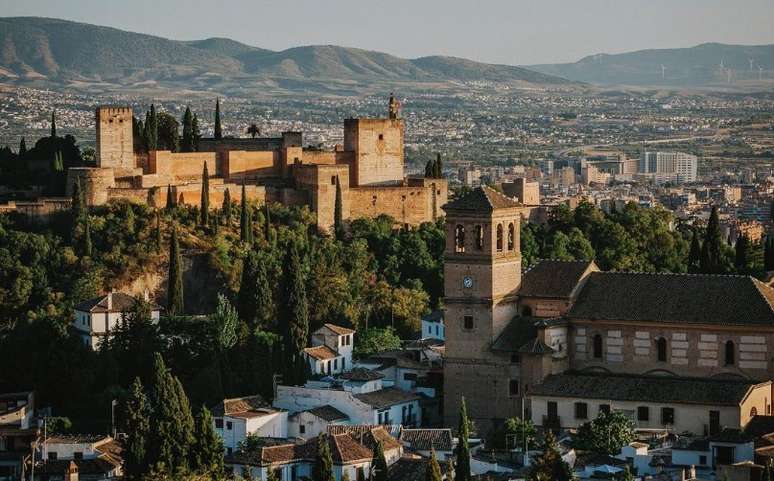The art and architecture of the Hispano-Muslim world make up a complex of splendid structures in the region of Andalusia
The landscape of the reddish walls of Alhambra, in Granada, enchants visitors at first glance. Designed between the 9th and 12th centuries, the Red Fortress (from the Arabic Qal’at al-hamra) is a historical complex consisting of a fort, a small citadel and several palaces.
The 14-hectare structure was built during the reign of Ibn al-Aḥmar, later called Muhammad I, the founder of the Nasrid dynasty, the last Muslim dynasty in the Iberian Peninsula.
In 1492, with the expulsion of the Moors and the reconquest of the Grenade by Catholics, the Alhambra it was transformed into a Christian court. Parts of the site were destroyed and others rebuilt in the Renaissance style by Charles V, who ruled Spain as Charles I (1516-1556).
The complex has survived to the present day as a fascinating union of elements of Islamic architecture and 16th-century Christian structures. It was declared a World Heritage Site by UNESCO in 1984, which then expanded the list in 1994 to include neighboring areas, such as the neighborhood of Albaycin and the Generalife Palace.
Attractions in the Alhambra
Highlights of the gigantic architectural complex include:
Porta de las Granadas and Porta Judiciaria: At the park’s lower entrance, visitors pass the Puerta de las Granadas, a triumphal arch dating back to the 16th century. Higher up is the Puerta Judiciaria, built as a horseshoe arch under a square tower. The structure was used by the Moors as an informal court of justice.
Nasrid Palaces: the palace portion is the most popular attraction in the region and requires purchasing tickets in advance. There are three main structures: the El Mexuar hall, the Palácio de Comares and the Palácio dos Leões.
Courtyard of the Lions: the enormous courtyard is flanked by a gallery supported by 124 white marble columns, richly decorated with Moorish style carvings. In the center of the courtyard is the famous Fountain of the Lions, a large alabaster basin supported by 12 white marble lions, a symbol of strength and courage.
Comares Palace: to the west of the main courtyard, the entrance to the palace has an ornate portal and the path to El Mexuar, inside the Torre de Comares. The largest room in the Alhambra is 11 meters square and has a dome decorated with Islamic motifs 23 meters high. The large hall was occupied by the sultan’s throne and was used for large receptions.
Generalife: located east of the fortress, the name derives from Arabic Jannat al-ʿArīf and means “Architect’s Garden”. The structure with courtyard and adjacent buildings served as the sultan’s summer residence, residence for passing emirs and leisure area for the nobility.
Albaycín and San Nicolas viewpoint: The residential neighborhood of Albaycín is the best preserved version of a Spanish-Muslim city, with buildings that harmoniously combine Christian Renaissance and Spanish Baroque cultures. Across the Darro River, visitors can enjoy the sunset from the San Nicolás viewpoint overlooking the entire Alhambra to the sound of flamenco music
What you need to know to visit the Alhambra
The complex is one of the most visited in the whole Spain That’s why you need to plan your visit in advance. Six thousand visitors are allowed into the palaces per day, and entrance tickets are rarely available. Advance purchase can be made via the official website, where you can also find more information.
Pay attention to what each ticket offers: garden tickets don’t give access to other spaces, and night tickets split visits over two days, for example. Information can also be found on the ticket website.
For the complete visit the ticket costs €19.09 (approximately R$115). For children under 12, tickets are free, but must be validated in advance to guarantee access. Tickets for children under 3 years old do not need to be booked in advance and can be collected at the physical box office.
For your visit, be prepared with comfortable clothes, sun protection and walking shoes, as the place has many stairs, ups and downs. In the European summer months, the city is extremely dry and temperatures can exceed 40ºC on the worst days. Bring water and take advantage of the fountains along the route to fill up.
+ Civitatis offers a guided tour of the Alhambra including the Nasrid Palaces
How to get to the Alhambra
Grenade is located 420 km south of Madrid and 250 km east of Seville, the main city of Andalusia – you can travel by car, intercity bus or train to get there.
Once in the city, to arrive Alhambrathe options available are bus lines C3 and C4, departing from Plaza Isabel La Católica, and the tourist train “Granada City Tour”.
By car or taxi the route is via Ronda Sul, as direct access from the city center is prohibited for private vehicles.
Discover the best flight options to Spain
Source: Terra
Ben Stock is a lifestyle journalist and author at Gossipify. He writes about topics such as health, wellness, travel, food and home decor. He provides practical advice and inspiration to improve well-being, keeps readers up to date with latest lifestyle news and trends, known for his engaging writing style, in-depth analysis and unique perspectives.









